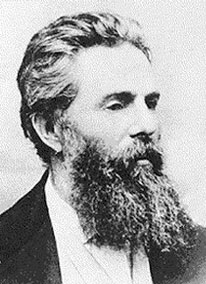Издателство |
| :. Издателство
LiterNet |
Медии |
| :. Електронно списание LiterNet |
| :. Електронно списание БЕЛ |
| :. Културни
новини |
Каталози |
| :. По
дати : Март |
| :. Електронни книги |
| :. Раздели / Рубрики |
| :. Автори |
| :. Критика за авторите |
Книжарници |
| :. Книжен
пазар |
| :. Книгосвят: сравни цени |
Ресурси |
| :. Каталог за култура |
| :. Артзона |
| :. Писмена реч |
За
нас |
| :. Всичко за LiterNet |
HERMAN MELVILLE
(1819-1891)
 Herman
Melville was born on the first of August in 1819 in New York City, the third
of eight children of Allan and Maria Gansevoort Melvill. His ancestors included
several Scottish and Dutch settlers of New York as well as prominent leaders
in the American Revolution. His paternal grandfather, Major Thomas Melvill,
was a member of the Boston Tea Party and his maternal grandfather, General Peter
Gansevoort, was renowned for leading the defense of Ft. Stanwix against the
British during the revolution.
Herman
Melville was born on the first of August in 1819 in New York City, the third
of eight children of Allan and Maria Gansevoort Melvill. His ancestors included
several Scottish and Dutch settlers of New York as well as prominent leaders
in the American Revolution. His paternal grandfather, Major Thomas Melvill,
was a member of the Boston Tea Party and his maternal grandfather, General Peter
Gansevoort, was renowned for leading the defense of Ft. Stanwix against the
British during the revolution.
Melville's father was involved in the felt and fur import business, yet in 1830 his business collapsed and the Melvill family moved from New York City to Albany, where Allan Melvill died two years later. As a child, Herman suffered from extremely poor eyesight caused by a bout of scarlet fever, but he was able to attend Male High School despite his difficulties. Herman Melville worked as a bank clerk before attending the Albany Classical School, and then worked for a short time as a teacher in Pittsfield, Massachusetts.
Although he studied surveying at Landingsburgh Academy in order to take part in the Erie Canal Project, he did not gain a post with the project and instead shipped out of America as a cabin boy on the St. Lawrence bound for Liverpool. By this time, Melville had already started writing. In January of 1841 Melville undertook a second voyage on the whaler Acushnet from New Bedford to the South Seas. By June of the following year the Acushnet landed in the Polynesian Islands, and Melville's adventures in this area became the basis for his first novel, "Typee" (1846). This novel is the reputed story of his life among the cannibalistic Typee people for several months in 1842, but is likely a highly fictionalized dramatization of the actual events. Melville's second novel, "Omoo" (1847) detailed the adventures of another whaling journey in which Melville took part in a mutiny and landed in a Tahitian jail from which he later easily escaped.
Melville took his final whaling voyage as a harpooner on the Charles & Henry, but left the voyage while on the Hawaiian Islands and returned to America as a sailor on the United States, reaching Boston in 1844. By the time that Melville reached America once more, his family's fortunes had dramatically improved: his brother Gansevoort had become the secretary for U.S. legation in London under the Polk Administration. Melville could now support himself solely by writing, and his first two novels were notorious successes. In August 1847 Melville married Elizabeth Shaw, daughter of the Chief Justice of Massachusetts, and he began a new book, "Mardi", which would be published in 1849. The novel was another Polynesian Adventure, but its fantastical elements and jarring juxtaposition of styles made it a critical and commercial disappointment. The successes "Redburn" (1849) and "White-Jacket" (1950) returned to the style that had made Melville renowned, but neither work expanded Melville's reputation.
In the summer of 1850, spurred by the influence of Nathaniel Hawthorne's "The Scarlet Letter", Melville bought the Arrowhead farm near Pittsfield so that he could live near Hawthorne, and the two men, who shared similar philosophies, became close. This relationship with Hawthorne reawakened Melville's creative energies, and in 1851 Melville published his most renowned novel, "Moby Dick". Although now heralded as a landmark work in American literature, the novel received little acclaim upon its release. He followed this with "Pierre" (1852), a novel that drew from Melville's experiences as a youth, and the modest success "Israel Potter" (1855). Melville's most significant works outside of "Moby Dick" include the short stories that he wrote during this time period, including "Bartleby the Scrivener" (1853) and "Benito Cereno" (1855).
In 1856 Melville journeyed to Europe to travel, and he followed this with the publication of "The Confidence Man" (1857), the final novel that Melville would publish during his lifetime. Melville instead devoted himself to lecture tours and a global voyage that he abandoned in San Francisco. He published some poetry in his remaining years, but these works were of little note.
Melville's final years were marked by personal tragedy. His son Malcolm shot himself in 1867, and another son, Stanwix, died after a long and debilitating illness in 1886. During his final years Melville did return to writing prose, and completed the novel "Billy Budd", which was not published until 1924, several decades after his death. Melville completed "Billy Budd", the story of a sailor who accidentally kills his master after being provoked by a false charge. Melville finished the novel in April of 1891, and five months later he died on September 28 in New York City.
=============================
© E-publisher LiterNet, 17.04.2009
The Sun Is but a Morning Star. Anthology of American Literature. Edited by Albena
Bakratcheva. Varna: LiterNet, 2008-2010.
